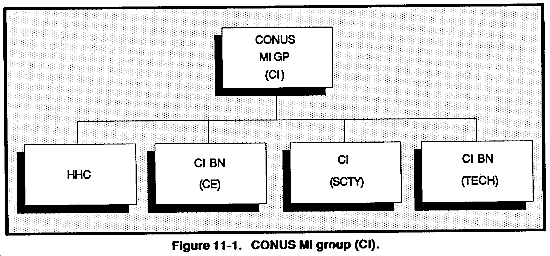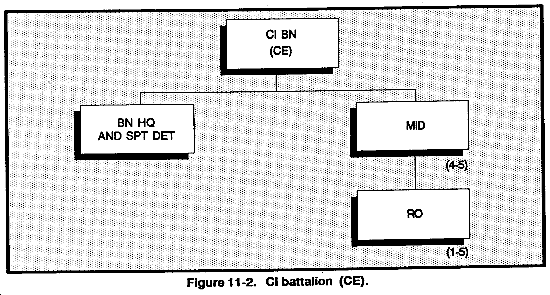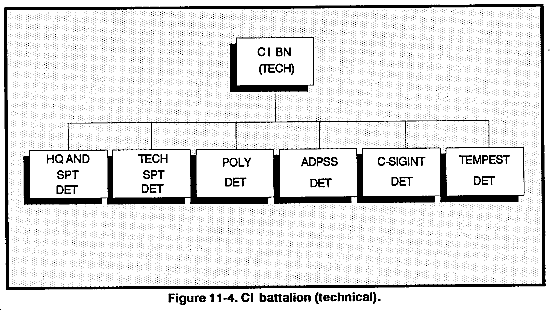FM 34-37: Echelons Above Corps (EAC) Intelligence And Electronic Warfare (IEW) Operations
CHAPTER 11
CONTINENTAL UNITED STATES MILITARY INTELLIGENCE GROUP (COUNTERINTELLIGENCE) (ECHELONS ABOVE CORPS)
This chapter addresses the CI EAC mission and structure in the CONUS theater. It discusses the resources available and how they provide CI support to MACOM commanders and DA and DOD agencies. It discusses, too, the functional and coordination structure of the CONUS MI group (CI) and provides insight into the duties of the key elements of the group and how they interact.
MISSION
The mission of the CONUS MI group (902d MI Group) (CI) is to conduct MDCI functions, specialized CI training, and technical support services for DA and other organizations as directed by the commanding general (CG), INSCOM. This group is a major peacetime source of CI support in CONUS. It is the only wartime CONUS EAC CI unit and is designed to meet all CI support requirements in its AO. This group's assets are tailored to support--
- Unified, joint, and combined commands.
- Other US Army EAC commands.
- US Army corps and divisions.
- DOD agencies.
The functions of the group are to--
- Provide all-source CI support to commanders and heads of DA and DOD activities having proponency for special access programs (SAPs).
- Plan, conduct, and manage CI investigations and operations in CONUS.
- Conduct investigations on categories II through VI SAEDA cases and miscellaneous cases as directed (see AR 381-12).
- Establish and operate a CI subcontrol office to manage CONUS investigations and operations.
- Provide technical CI services and validation services, to include regulatory tests and inspections.
- Conduct polygraph examinations for INSCOM and other DOD activities.
- Provide ADP security support as directed by INSCOM to the Army through the conduct of comprehensive ADP security services, engineering services, software analysis services, and advice and assistance.
- Provide CONUS-wide TSCM investigations to detect and neutralize technical surveillance penetrations, technical surveillance hazards, and physical security weaknesses.
- Conduct laboratory analysis of technical surveillance devices and technical surveillance hazards worldwide.
- Provide defense against methods of entry (DAME) services to INSCOM and provide technical DAME advice and assistance worldwide as directed.
- Approve Army cryptofacilities in CONUS before establishment, alteration, expansion, or relocation.
- Review plans for new construction of and provide field TEMPEST test support to select Army facilities. These facilities are designed to process classified information electronically to ensure adequate protection against compromising emanations.
- Assist CONUS commanders in developing and evaluating C-SIGINT policies, plans, operating procedures, and programs.
- Provide C-SIGINT support to CONUS EAC units or facilities and provide C-SIGINT collection support to ECB tactical units and the Army RCs.
- Collect and analyze emissions of Army emitters. It does this during developmental and operational testing of weapons systems and during field training exercises (FTXs) to determine their vulnerability to SIGINT exploitation.
- Provide CI support to commanders at EAC to aid in the establishment of unit OPSEC programs.
- Establish and maintain operational coordination with local, state, and Federal investigative, law enforcement, and intelligence organizations to fulfill mission requirements.
- Provide support to the NCA's Alternate Joint Communications Center.
- Conduct CI collection activities in CONUS.
- Provide dedicated CI support to the Defense Nuclear Agency (DNA) and its field activities.
- Provide specialized CI training.
The CONUS MI group (CI) is organized for peace and would require modification for war. In peacetime, support requirements from supported commands are usually well defined, sufficiently scoped, adequately planned and resourced, and routinely conducted. Peacetime requirements, although intense, are functionally focused and demand timely response.
In peacetime, the group plans for transition to war based on the documented threat to mobilization, new or additional missions, or location of supported activities and resources. In wartime, certain functional areas would demand less emphasis while a focus on the CONUS sustaining and training base would expand. Once combat operations begin, there will be a change in focus to securing and protecting wartime capabilities, operations, and activities in the CONUS theater.
ORGANIZATION
The CONUS MI group (CI), shown at Figure 11-1, has an HHC and three CI battalions: CE, security, and technical.
HEADQUARTERS AND HEADQUARTERS COMPANY
The HHC commands and controls all assigned and attached units. It contains elements to perform all the functions normally associated with a unit of this type.
Group headquarters consists of the group commander, deputy commander, CSM, and the command section. The commander defines and assigns the group mission, establishes objectives, and designs concept of operations. The commander's objectives guide the actions of the staff and subordinate commanders during an operation. The group commander becomes personally involved in group CI operations by identifying information needs, directing their fulfillment, and following up to ensure instructions are carried out.
The deputy commander represents the group commander in matters of command authority and responsibility when the commander is not available. Specifically, he performs group headquarters operations and maintains essential group links with critical support elements.
The group CSM is responsible to and takes direction from the group commander. The CSM advises the commander about training, discipline, health and welfare, morale, and esprit de corps of the enlisted members.
The S1 serves as the adjutant and is the primary staff officer for all military and civilian personnel administrative matters. The S1 has OPCON over the information management office (IMO). The IMO is responsible for the group's automation management and training and distributes and reproduces information.
The S2 is the principal staff officer who formulates, develops, implements, and supervises policies and procedures pertaining to internal security, multidiscipline threat dissemination, and national level liaison and intelligence oversight for the group's CONUS mission.
The S3 manages field operations, formulates plans, and oversees training for the group. The S3--
- Develops, coordinates, directs, and monitors group CI support operations, services, plans, and programs; individual and unit training; force development requirements; and RC support and training.
- Prepares, coordinates, implements, and interprets group operational policy.
- Prepares and coordinates staff actions for special projects.
- Recommends distribution of group personnel, funds, and equipment resources.
- Prepares and recommends changes to group modification table of organization and equipment (MTOE) and TDA documents.
- Evaluates unit performance.
- Coordinates group support to the SAP.
INSCOM levies mission tasking directly to the CONUS MI group (CI). The group commander and staff determine which subordinate battalion is best suited for the mission. The S3 tells the commander the status of CI operations, readiness, and unit training.
The S4 is the principal staff officer responsible for--
- Supply.
- Maintenance.
- Movements.
- Contracting.
- Facilities management and maintenance.
- Procurement.
- Real estate management and leasing.
- Other logistic support to the group.
- Medical, environmental, and food service coordination as required.
The resource management office (RMO) is a special staff section responsible for budget and manpower. The RMO--
- Ensures that all manpower and equipment requirements are properly reflected on each unit's organization documents.
- Establishes and administers an effective financial management program.
- Provides fiscal management to include planning, committing, obligating, administering, and monitoring battalion funds.
- Prepares, executes, and administers battalion contracts.
- Advises battalion and subordinate commanders on budgeting and fiscal policies.
COUNTERINTELLIGENCE BATTALION (COUNTERESPIONAGE)
The mission of the CI battalion (CE) is to conduct investigations and operations in response to alleged espionage against the US Army.
Investigative support is provided to EAC units and designated DOD activities within CONUS, Alaska, and Puerto Rico, or as otherwise directed by the group commander.
ORGANIZATION
This battalion performs its mission through geographically dispersed military intelligence detachments (MIDs), executing the battalion's mission in a specific area. These MIDs are further broken down as needed into resident offices (ROs) to facilitate battalion mission execution. The number of MIDs and ROs are tailored to mission requirements.
Typically the CI battalion (CE), shown at Figure 11-2, has a headquarters and support detachment, four-to-five MIDs, and one-to-five ROs for each MID.
BATTALION HEADQUARTERS AND SUPPORT DETACHMENT
The battalion commander is the primary CE officer within the group and is directly responsible to the commander for CE matters. The battalion provides GS CE coverage to CONUS units, with elements deployed throughout CONUS. The headquarters support detachment consists of a detachment commander, noncommissioned officer in charge (NCOIC), and administrative personnel to perform routine personnel, administrative, and supply actions for personnel assigned to the battalion headquarters.
The battalion staff is organized on a standard basis, with an S1, S2, S3, S4, and RMO. Each section has responsibility for its functional area throughout the battalion.
The S1 provides administrative support to all battalion elements.
The S2 manages intelligence collection, to include processing intelligence through an internal battalion CI analysis cell. The S2 serves as the security manager and ensures that security information and battalion physical and personnel security needs are met.
The S3 manages the battalion's CE operations throughout the US, to include overseeing case control, administration, and execution of CE investigations. The S3 reviews and monitors the battalion's CI special operational concepts, special operations, and current intelligence reports to obtain timely knowledge of FIS targeting and methods. The battalion also provides OPSEC advice and assistance to the Federal On-Site Inspection Agency (OSIA).
The S4 provides logistical support and administration to battalion elements, to include--
- Property books.
- Hand receipt creation and maintenance.
- Logistical acquisitioned accountability management.
- Coordination of local purchase and shelf-program acquisitions with installation activities and administration of battalion fleet operations, to include coordination with the General Services Administration.
MILITARY INTELLIGENCE DETACHMENT
The MID is the C² element of subordinate CI ROs in the conduct of the CI mission. The MID--
- Conducts CI operations and activities to include CE investigations, operations, and services.
- Supports C-SIGINT functions, SAPs, cryptofacility validations, cryptonet security evaluations, and personnel security screening program interviews.
- Conducts operational coordination with local, state, and Federal law enforcement and intelligence agencies.
- Conducts SAEDA and FIS threat briefings.
MILITARY INTELLIGENCE BATTALION
(COUNTERINTELLIGENCE) (SECURITY)
The MI battalion (CI) (security) provides integrated CI support to SAPs, selected DA or DOD contractors, and selected DOD and Federal agencies in CONUS and outside continental United States (OCONUS) areas, as directed by the commander. The battalion also provides dedicated CI support to US Army SOF, DNA, OSIA, and Strategic Defense Command.
ORGANIZATION This battalion, shown at Figure 11-3, is organized with a headquarters and support detachment and separate MIDs and ROs tailored to support specific CI security mission requirements. In addition, the battalion has a special operations security support detachment (OSD) and a CI support detachment. As the unit is organized functionally (not geographically), each detachment is configured differently.
BATTALION HEADQUARTERS AND SUPPORT DETACHMENT
The CI battalion (security) commander is responsible to the group commander for all activities of the battalion. The battalion commander is authorized direct coordination with supported US Army elements and designated DOD agencies to accomplish the mission. The group commander issues directives, investigation authorizations, policy planning and programming guidance, approved programs, and resource allocations.
Although many of the subordinate detachments are in DS of CONUS-wide local commanders or program managers, the CI battalion (security) commander retains C². The headquarters and support detachment consists of a detachment commander, NCOIC, and administrative personnel to perform routine personnel, administrative, and supply actions for battalion headquarters personnel.
The S1 serves as the adjutant for the battalion and is the primary staff officer for all military and civilian personnel matters.
The S2 is responsible to the commander for all personnel, document, and information security of the battalion. The S2 serves as the battalion security manager and the badge and credential custodian. The S2 coordinates and conducts internal security inspections and appropriate security education programs.
The S3 coordinates C-HUMINT, C-SIGINT, plans, training, OPSEC advice and assistance, and CI operations in support of all US Army SAPs, treaty verifications, and the Strategic Defense Command.
The S4 handles all matters pertaining to logistics, maintenance, and procurement. The S4 advises and assists the commander, staff, and subordinate commanders on all matters pertaining to supply, maintenance, movements, services, and miscellaneous logistical support of the battalion.
The RMO ensures that all matters pertaining to budget, manpower, or internal controls are effectively managed.
MILITARY INTELLIGENCE DETACHMENTS
The primary mission of the MIDs of the MI battalion (CI) (security) is to provide OPSEC support to DA and DOD SAPs. MID commanders exercise C² over ROs subordinate to the detachment. MIDs--
- Conduct CI investigations and operations, as required.
- Provide CI support to active and reserve Army units.
- Conduct operational coordination with Federal, state, and local law enforcement, investigative, and intelligence organizations within assigned geographical areas of responsibility.
- Are generally organized geographically to support SAP-related facilities, organizations, and operations within a designated area of responsibility.
- Conduct CE operations and investigations and provide services for DA and other organizations, as directed by CG, INSCOM.
- Provide OPSEC advice and assistance to SAPs in a GS role.
- Keep the group headquarters informed on the SAP's activities and milestones.
- Ensure that local hostile intelligence threat estimates are correct and tailored to SAP requirements.
- Help local program managers prepare requests for TSCM, TEMPEST, and other security requirements.
- Conduct all CI operations in accordance with applicable regulations, laws, and statutes as directed.
OPERATIONS SECURITY SUPPORT DETACHMENT
The OSD develops, plans, coordinates, and oversees CI OPSEC support to DOD SAPs in a DS role. The OSD receives its taskings through the chain of command from the Deputy Under Secretary of Defense (Policy). An OSD assessment team determines the feasibility and scope of the proposed SAP. Once granted SAP status, the OSD provides OPSEC advice and assistance from the conception of the SAP; through the research and development cycle, testing, and fielding; or through activation of the SAP. This enhanced security program is continued until the Vice Chief of Staff, US Army, decides to discontinue the SAP.
The chief of the DS teams subordinate to the OSD briefs the security posture of each SAP during the annual SAP Oversight Committee and makes recommendations for the revalidation of the programs. The OSD acts as the "eyes and ears" of the Deputy Chief of Staff for Intelligence and the Technology Management Office, as they ensure adherence of adequate OPSEC procedures.
The OSD also coordinates with the Defense Investigative Service to ensure that DOD contractors comply with appropriate SAP personnel security procedure guides, DODD 5220.22M, and DODD 5220.22R. The OSD deals primarily with the DA staff, national level intelligence activities, MACOMs, national test facilities, and SAP program managers. The OSD does not have geographical AOs.
DEFENSE NUCLEAR AGENCY MILITARY INTELLIGENCE DETACHMENT
The DNA MID performs the same mission as the OSD but provides dedicated, tailored CI and OPSEC support services to DNA and its field activities at locations throughout CONUS.
COUNTERINTELLIGENCE SUPPORT DETACHMENT
Like the DNA MID, the CI support detachment provides dedicated OPSEC support. This detachment supports SOF during training missions. It provides CI and security investigation support to them as directed by DA. Although the detachment receives its operational taskings from DA, C² of the detachment remains with the commander, MI battalion (CI) (security).
MILITARY INTELLIGENCE BATTALION
(COUNTERINTELLIGENCE) (TECHNICAL)
The MI battalion (CI) (technical) provides technical services and training in support of DA and DOD organizations. It acts as proponent for Armywide technical CI investigations, services, and instructions. This battalion performs a GS mission for EAC units and conducts the following technical CI functions:
- TSCM.
- DAME support.
- Polygraph testing.
- Automatic data processing security service (ADPSS) support.
- C-SIGINT monitoring.
- TEMPEST inspecting and testing.
The CI battalion (technical), shown at Figure 11-4, includes a headquarters and support detachment, technical support detachment, polygraph detachment, ADPSS detachment, C-SIGINT detachment, and TEMPEST detachment.
HEADQUARTERS AND SUPPORT DETACHMENT
The headquarters and support detachment has a battalion headquarters, support team, and training team. It provides C² of organic and attached units of elements; provides staff planning, communications, logistics, personnel, and administrative support; and provides CI support and specialized CI training.
TECHNICAL SUPPORT DETACHMENT
The technical support detachment consists of a headquarters section, TSCM operations team, countermeasures support team, and a DAME team. (See FM 34-60A and FM 34-60.)
POLYGRAPH DETACHMENT
The polygraph detachment consists of a headquarters section, training team, operations team, and screening team. It schedules examinations, reviews case files, conducts examinations, and prepares reports to determine the truthfulness of gathered information and screening.
AUTOMATIC DATA PROCESSING SECURITY SERVICE DETACHMENT
The ADPSS detachment consists of a headquarters section, systems testing and evaluation branch, analysis team, and field evaluation team. The testing and evaluation branch is augmented by six additional mobilization designee evaluation teams in wartime.
The ADPSS detachment provides ADP security support in accordance with AR 380-380 to units within the AO. It does this by conducting full ADP security, engineering, and software analysis services and by providing advice and assistance. On request, it also provides technical assistance in CE investigations. The detachment provides assistance and evaluation on automation security, including--
- Security management.
- Hardware security.
- Communications security.
- Information security.
- Software security.
- Procedural security.
- Personnel security.
- Physical and environment security.
COUNTER-SIGNALS INTELLIGENCE DETACHMENT
The C-SIGINT detachment consists of a detachment headquarters section, C-SIGINT teams, an electronic security (ELSEC) team, and cryptofacility inspection teams. It provides COMSEC, ELSEC, and ECCM advice and assistance.
Highly technical communications and EM collection and analysis equipment may be organic to the detachment to support selected research, development, test, and evaluation; other Army programs; and ECB C-SIGINT collection requirements.
TEMPEST DETACHMENT
The TEMPEST detachment consists of a headquarters section, testing team, and field evaluation team.
It inspects classified information-processing facilities to ensure compliance with and to detect deviation from approved installation practices as outlined in applicable technical bulletins and regulations. It also conducts TEMPEST tests (laboratory-type examinations under controlled conditions) and field tests to determine the existence and nature of conducted or radiated signals from electronic equipment.
|
NEWSLETTER
|
| Join the GlobalSecurity.org mailing list |
|
|
|





